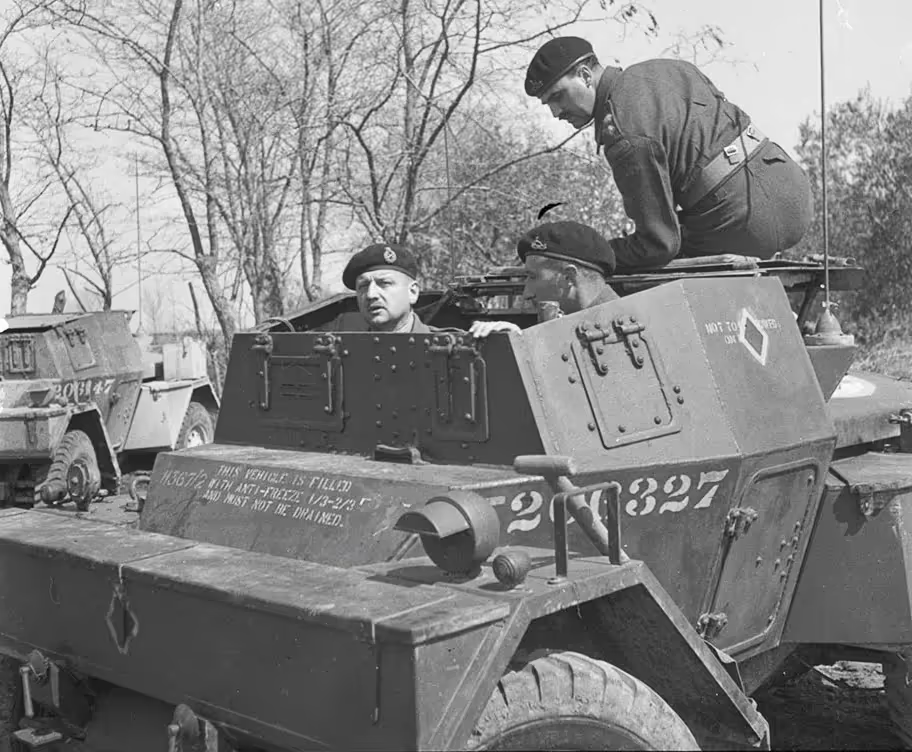Armour in Canada: Lynx and Dingo Armoured Scout Cars
Canadian Lynx and Dingo Armoured Scout Cars

(Library and Archives Canada Photo, MIKAN No. 3224300)
4th Canadian Armoured Division's drive towards Oldenburg. After the fall of Sogel, Lt. A.H. Hurd and trooper J.A. Lindell use a window dummy with German steel helmet as their Lynx armoured scout car mascot, 10 April 1945.
The Lynx Scout Car was built in Canada and based on a British vehicle called a Dingo. The "Scout Car, Ford, Mk. I", also called "Lynx") was built with a more powerful, Ford V8 95 hp (71 kW), engine, transmission and running gear. The vehicle superficially resembled the Dingo in general arrangement and body shape, was approximately a foot longer, wider and taller, a ton and a half heavier, less nimble [the turning circle was 47 ft (14 m)] and was louder. While rugged and dependable, it was not as popular as the Dingo, due to the intended use of covert intelligence gathering. Total production figures for each type were 6,626 for the Dingo (all marks) 1939–1945 and 3,255 for the Lynx 1942–1945. (Wikipedia)
The Lynx was used by Canadians serving in Armoured Car Regiments, Armoured Reconnaissance Regiments, Armoured Regiments, Reconnaissance Regiments, Armoured Division Headquarters and by Royal Canadian Signals in armoured formations. it has been described as a small mobile vehicle useful for short recces on a regimental front. It could also be used by recce troops in lieu of light tanks, but could not operate over rough heavy going ground or against anti-tank gun opposition.
The Lynx was armed with a .303 Bren Gun, Rifle, and came equipped with a No. 19 Wireless Transmitter set. It carried tools, spare gun parts, rations, and a camouflage net. It was protected with 30-mm thick armour in the hull front, and 12-mm on the sides and rear and 6-mm on the roof. Its engine and radiator were rear mounted.
Ford Canada in Windsor, Ontario built two types of Lynx; the Lynx II featured a strengthened chassis and no roof. A total of 3,255 units were built in Canada. (www.Canadians.com)

(Library and Archives Canada Photo, MIKAN No. 3524486)
Lynx Scout Car, 8th Royal Scots & 1st Canadian Parachute Battalion after crossing the Rhine River, Bergerfarth, Germany, 25 Mar 1945.

(Author Photo)
Lynx Scout Car Mk. II (Serial No. CF52389), Canadian War Museum, Ottawa, Ontario. The Lynx has a fuel tank below the hull door. The wheels on the Lynx and Dingo are different, as well as the headlight and horn.

(Ford Canada Photo)
Ford Canada Lynx Scout Car.

(DND Photo)
Lynx Scout Car.

(Library and Archives Canada Photo, MIKAN No. 3196712)
Lynx Scout car and heavy personnel carrier being test driven on a hill at the ceremony to commemorate Canada's 500,000th military vehicle, a battery charger lorry, June 1943.

(Library and Archives Canada Photo, MIKAN No. 3194752)
Dingo Scout car which the Lynx is based on, abandoned during the raid on Dieppe, 19 August 1942.

(Library and Archives Canada Photo, MIKAN No. 3225552)
Sergeant Walter Crampton digging beside his Lynx scout car in Normandy, 19 July 1944.

(Library and Archives Canada Photo, MIKAN No. 3240447)
Troopers W. Balinnan and G-3311 Tpr Arthur Gallant from Shediac, New Brunswick, of the Royal Canadian Dragoons reconnaissance regiment in a Dingo scout car, speaking to partisans Louisa and Italo Cristofori after the capture of Bagnacavallo, Italy, 3 January 1945. Louisa is armed with a well-used Thompson M1929 SMG.

(Library and Archives Canada Photo, MIKAN No. 3524796)
Dutch civilians and members of the 8th Reconnaissance unit, 2 Canadian Infantry Division, during liberation of Beveland province, the Netherlands. Oostkerke, Netherlands, 1 November 1944.

(Library and Archives Canada Photo, MIKAN No. 3203521)
Major General E.L.M. Burns, Officer of the Order of the British Empire, Military Cross, in a Dingo scout car at Corps Headquarters, 18 March 1944.




